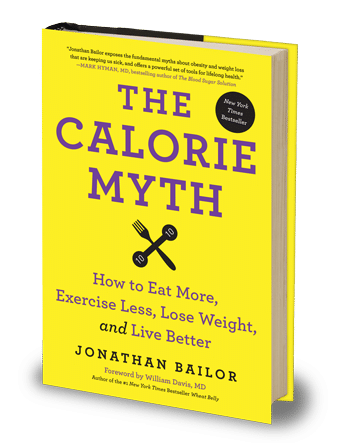20 Ways to Alleviate Phlegm After Eating
Here are 20 2ays to alleviate phlegm after eating and if you haven’t seen our in depth original guide – check out SOLVING THE MYSTERY OF PHLEGM AFTER EATING: 10 CAUSES AND EASY SOLUTIONS next or the Does Peanut Butter Cause Phlegm? Debunking Food Myths guide!
Are you ready to end that annoying phlegm after eating and enjoy pleasant dining experiences again? Here are effective tips to do just that in this coughing and phlegm guide by Jonathan Bailor!
Encountering excessive phlegm production after dining isn’t just a fleeting discomfort; it’s an experience that can subtly overshadow the pleasure of a nourishing meal, leaving us with a sense of unease. While not an uncommon occurrence, it often lurks in the background of our dining experiences, unspoken yet persistent. Why does this happen? Is it a mere byproduct of our meals, or does it signal something deeper about our body’s relationship with food?
Embarking on this exploration, we aim to shed light on the reasons behind post-meal phlegm and its broader implications for our well-being. This is a conversation not about obscure medical phenomena but about our everyday experiences and the subtle signals our bodies give us. Recognizing these signs is crucial to navigating better health and comfort.
This dialogue resonates with many, as it touches on a common yet under-discussed aspect of our health. Whether you’re directly affected by this issue or know someone who is, the insights here are meant to enlighten and empower. This journey is not about deciphering complex medical terms; it’s about understanding our bodies and their interactions with the food we cherish.
As we delve into this topic, we’re not just seeking answers but fostering a community of sharing and understanding. Knowledge, especially about our bodies’ reactions to food, gains its true value when shared and discussed openly. Whether it’s a conversation over a family dinner or a shared insight on your favorite social platform, bringing this topic into the open can create a ripple of awareness and understanding.
Our exploration here is just the beginning. We’re set to dive deeper into the nuances of this condition, offering a comprehensive guide to managing and coexisting with post-meal phlegm. Stay tuned for detailed insights in the sections to come, and remember, this journey toward understanding and comfort is one we embark on together.
Harmonizing Your Lifestyle: Beyond Diet and Exercise for Managing Post-Meal Phlegm
When we think of enhancing our health, diet and exercise often take center stage. However, there’s a broader spectrum of lifestyle choices that play a pivotal role in our well-being, particularly in managing conditions like post-meal phlegm. These choices form the tapestry of our daily lives, subtly influencing how we feel and function. In this exploration, we look beyond the usual suspects of diet and physical activity to uncover other lifestyle adjustments that can significantly impact our experience with phlegm after meals. These changes are about creating an environment and a routine that supports our body’s natural processes and responses, leading to a more comfortable and harmonious life.
1. Hydration Habits
While not directly linked to diet, the way we hydrate ourselves throughout the day plays a crucial role. Ensuring consistent hydration helps maintain mucus at a manageable level. It can also help reduce stomach acidity for a short time. (Acid reflux is a common contributor to phlegm after eating.)
It’s not just about the quantity of water; it’s about making hydration a regular part of your routine. Carrying a water bottle, setting reminders, or even integrating herbal teas can significantly affect how our body handles mucus production.
2. Sleep Quality and Position
Good sleep isn’t just restorative for the mind; it also impacts how our body manages mucus. Sleeping in a slightly elevated position can help prevent mucus from pooling in the throat, which is common during horizontal sleep. Investing in quality pillows or adjustable beds can aid in finding a comfortable sleeping position that reduces post-meal phlegm discomfort.
3. Stress Management Techniques
Although often overlooked, our emotional state can influence physical symptoms like phlegm production. High-stress levels can exacerbate bodily reactions, including mucus production. Incorporating stress-reduction practices like mindfulness, meditation, or even simple breathing exercises into our daily routine can positively impact how our body reacts to stress and, consequently, mucus production.
4. Regular Vocal Hygiene
For those who use their voice extensively in daily life, vocal hygiene can play a role in managing throat health. Taking regular breaks during long speaking engagements, staying hydrated, and avoiding straining the voice can help reduce throat irritation, thereby minimizing the body’s protective mucus response.
Each of these lifestyle changes offers a way to manage post-meal phlegm better, moving beyond the conventional focus on diet and exercise. These adjustments are about aligning our daily habits with our body’s needs, fostering an environment where comfort and health go hand in hand.
As we integrate these practices into our lives, we create a foundation for not just managing symptoms but thriving in our day-to-day experiences.
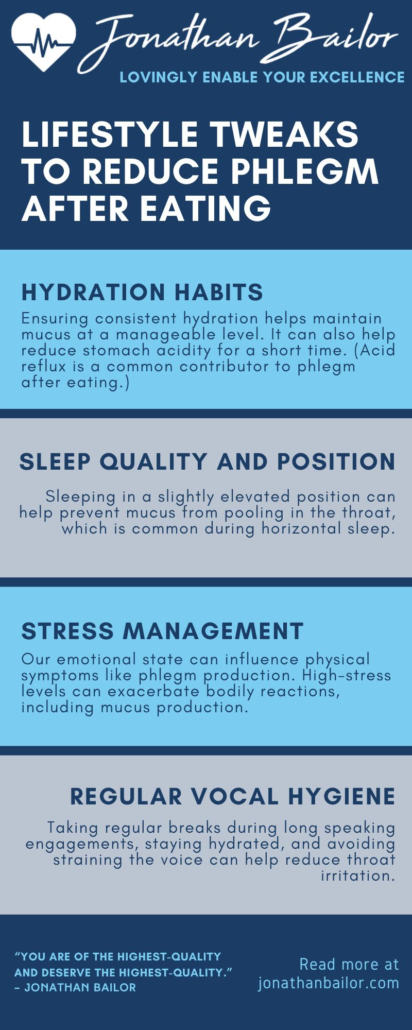
Feeling Better Is Priceless, That's Why We Don't Put A Price On It!
“It’s Like A Free and Medically Valid Version of Noom and Weight Watchers Online”
~ Dr. Doctor Matthew Oleshiak, MD
Click the 'LEARN MORE' button below for free lifetime access to the fast fix program developed by Jonathan and top Ivy League Medical Doctors
LEARN MOREP.S. It's not a free trial. It's not part of the program for free. The entire program is free, forever, for real! No credit card needed.
Dietary Adjustments for Minimizing Post-Meal Phlegm
In our quest to manage post-meal phlegm, diet plays an instrumental role. While it’s common to focus on foods we should avoid, it’s equally important to consider what we can incorporate into our diets to better manage this condition. This journey is not about restrictive eating but about making mindful choices that harmonize with our body’s natural processes. The following dietary changes are centered around nurturing and supporting our body, offering it the nutrients and care it needs to minimize the discomfort of post-meal phlegm. These aren’t just changes but steps towards a more comfortable and enjoyable eating experience.
1. Incorporate Herbal Teas
Herbal teas, particularly those with anti-inflammatory properties like ginger, turmeric, or licorice root, can be soothing for the throat. They help reduce irritation, which often leads to mucus production. Drinking these teas post-meal can aid digestion and provide a calming effect to the throat, thus managing phlegm production.
2. Increase Omega-3 Fatty Acids
Foods rich in omega-3 fatty acids, like flaxseeds, chia seeds, and fatty fish, such as salmon, have anti-inflammatory effects. These can help reduce inflammation in the body, including the throat and respiratory tract, thereby potentially decreasing mucus production. Incorporating these foods into your diet can offer twofold benefits: nutritional enrichment and phlegm management.
3. Add Pineapple to Your Diet
Pineapple contains bromelain, an enzyme that can help break down mucus and ease its expulsion. Consuming pineapple or juice can be a delicious way to manage phlegm production, especially after meals. It’s a natural, flavorful addition to your diet with the added benefit of aiding digestion.
4. Introduce Honey
Honey is known for its soothing properties and can be beneficial for throat health. It can help coat the throat, relieve irritation, and reduce the urge to clear the throat frequently. A spoonful of honey after meals or adding it to herbal tea can be a simple yet effective dietary addition.
5. Opt for Steamed Vegetables
Steamed vegetables are not only easier to digest but also less likely to cause irritation in the throat and esophagus. This cooking method retains the nutrients in the vegetables while making them gentle on the digestive system. Incorporating steamed vegetables into your meals can be a step towards reducing post-meal phlegm.
6. Choose Lean Proteins
Lean proteins like chicken, turkey, and fish are easier to digest and less likely to cause inflammation or mucus production compared to fatty meats. They provide the necessary nutrients without the added burden on your digestive system, which can sometimes trigger phlegm production.
These dietary changes are about creating a balance where food becomes not just a source of nourishment but also a means to manage physical discomforts like post-meal phlegm. By making these mindful choices, we move closer to meals that are not just satisfying but also harmonious with our body’s well-being.
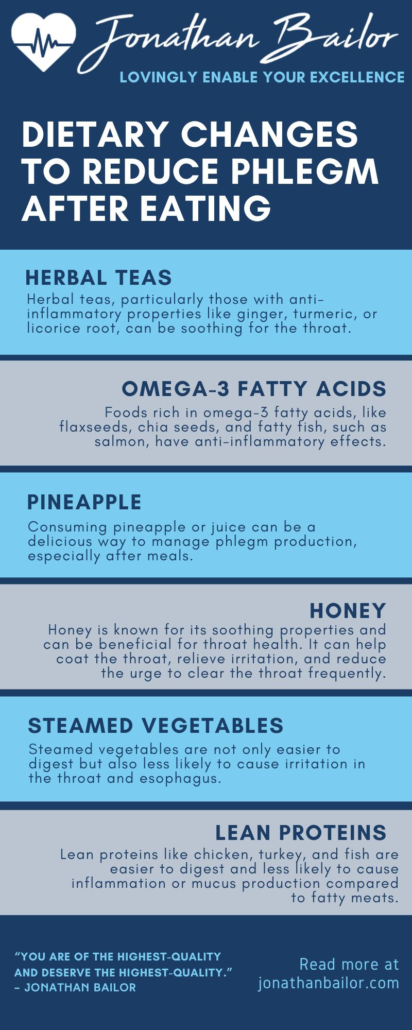
Physical Activities to Alleviate Post-Meal Phlegm
When addressing post-meal phlegm, the role of physical activity is often overlooked. Engaging in the right type of physical activity can be a significant step toward managing this discomfort. It’s about choosing exercises that enhance overall health, specifically reducing the effects of phlegm production. These activities are not about high-intensity workouts; rather, they focus on gentle movements and breathing techniques that align with our body’s natural rhythm and help manage respiratory issues. Here, we explore various physical activities that can positively reduce the sensation of phlegm after eating, enhancing the overall quality of life.
1. Gentle Walking
A leisurely walk post-meal can aid in digestion and help clear the airways. The gentle movement encourages circulation and can prevent mucus buildup in the throat. A short, relaxed walk, preferably in a clean, open environment, can make a noticeable difference in how you feel post-meal.
2. Yoga and Controlled Breathing
Yoga, especially with its emphasis on breathing techniques, can be highly beneficial. Practices like Pranayama (breath control) encourage deep, controlled breathing, which can help clear the airways and reduce phlegm. Gentle yoga postures after meals can also aid in digestion and mucus management.
3. Light Aerobics or Swimming
Engaging in light aerobic activities or swimming can help boost lung capacity and clear out phlegm. These activities promote deeper breathing and better oxygenation, helping the body to expel mucus naturally. However, it’s essential to wait for some time after eating before engaging in these activities.
4. Singing or Humming
Surprisingly, singing or humming can be an effective way to strengthen the respiratory system. These activities encourage deep breathing and can help loosen and clear phlegm from the throat. It’s a fun and therapeutic way to address this issue, improving your mood and respiratory health simultaneously.
5. Laughter Therapy
Laughter is not just a source of joy but also a physical activity that can aid in clearing the respiratory tract. Laughter deeply engages the diaphragm and abdominal muscles, promoting better lung function and helping to expel mucus.
Incorporating these physical activities into your daily routine can be a delightful and effective way to manage post-meal phlegm. Each activity offers a unique benefit, enhancing respiratory health and overall well-being. These practices, when performed regularly, can significantly improve your comfort and enjoyment after meals.
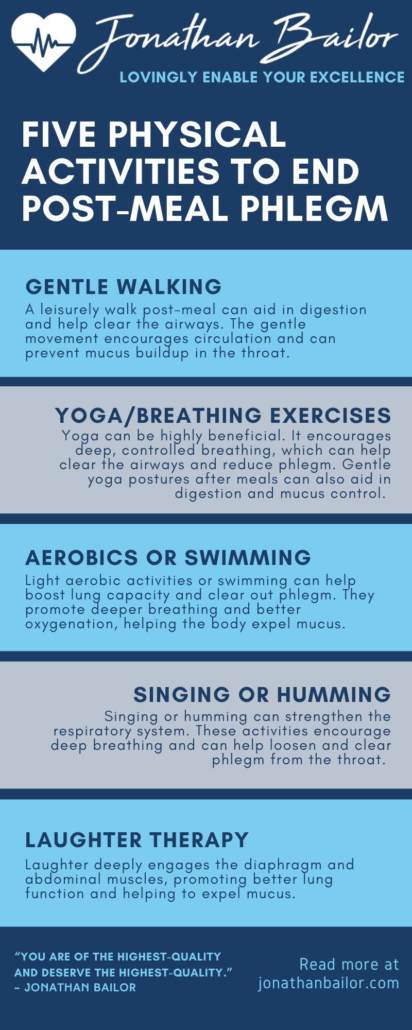
Cultivating Mind and Spirit: Mental and Spiritual Practices for Phlegm Management
In the intricate balance of health, the influence of our mental and spiritual state often goes unrecognized, especially in managing physical conditions like post-meal phlegm. These aspects of our being, subtle yet profound, can significantly impact how our body functions and reacts. Engaging in mental and spiritual practices is not just about seeking tranquility; it’s about creating a harmonious internal environment where bodily processes, including mucus management, can operate optimally. Here, we explore several mental and spiritual practices that can contribute to reducing the discomfort of post-meal phlegm, emphasizing the interconnectedness of mind, body, and spirit in achieving overall well-being.
1. Guided Visualization
Engaging in guided visualization can have a calming effect on the body, including the respiratory system. Visualizing a clear, open throat and airways can help mentally direct the body’s response to post-meal phlegm. This practice combines the power of the mind with the body’s inherent ability to regulate itself.
2. Meditation and Deep Relaxation
Regular meditation or deep relaxation techniques can reduce overall stress levels, which in turn can impact bodily functions like mucus production. These practices help in achieving a state of mental calmness and balance, creating a conducive environment for physical well-being.
3. Positive Affirmations
Using positive affirmations to promote health and well-being can be a powerful tool. Affirmations like “My body is capable of balancing itself” or “Every breath I take is soothing and healing” can reinforce a positive mindset, which may indirectly aid in managing post-meal phlegm.
4. Engaging in Spiritual Practices
For those with spiritual inclinations, engaging in regular spiritual practices like prayer or rituals can offer a sense of peace and well-being. This connection to a higher power or greater purpose can provide mental and emotional support, which in turn can positively affect physical health issues, including the management of post-meal phlegm.
5. Yoga Nidra or Sleep Yoga
Yoga Nidra, a form of guided relaxation performed in a lying-down position, can deeply relax the mind and body. This practice helps reduce stress and promote better respiratory function, potentially aiding in the management of post-meal phlegm.
Incorporating these mental and spiritual practices into our daily routine can offer profound benefits beyond immediate symptom relief. They provide a pathway to a more balanced and harmonious state of being, where managing conditions like post-meal phlegm becomes an integrated part of our journey toward holistic health.
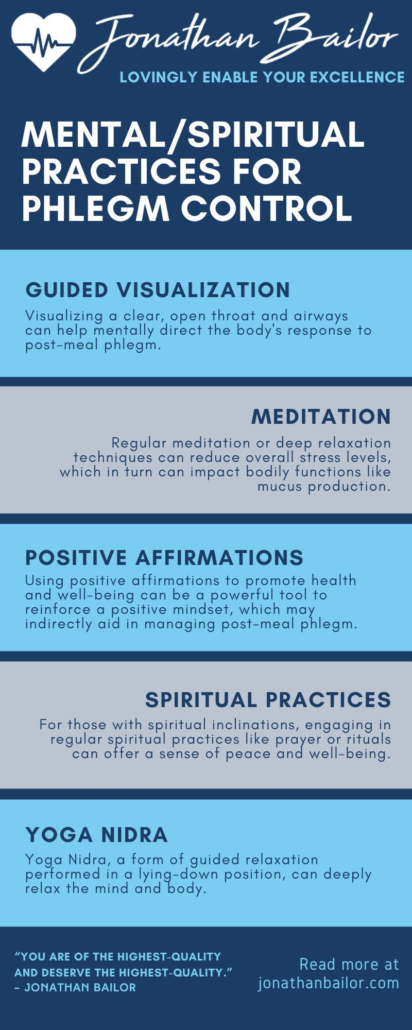
FAQ on Cough and Phlegm: Understanding and Managing Respiratory Health
In the realm of respiratory health, cough and phlegm are common symptoms that often raise questions and concerns. Understanding these symptoms is key to managing them effectively and maintaining a healthy respiratory system. This FAQ aims to address some of the common queries related to cough and phlegm, providing insights that are not only medically sound but also practical for everyday application. Here, we delve into the nuances of these symptoms, offering clarity and guidance to those seeking answers.
Q1: What causes phlegm to increase after eating?
Phlegm production after eating can often be attributed to certain foods that may irritate the throat or trigger allergic reactions. Dairy products, for instance, can cause an increase in mucus production for some individuals. Additionally, spicy foods and those high in acidity can stimulate the mucus membranes, leading to increased phlegm. Conditions that can contribute to phlegm after eating include acid reflux/GERD, laryngopharyngeal reflux (also called silent reflux), food allergies, respiratory infections, an asthma attack, and aspiration pneumonia. Understanding your body’s reactions to different foods can help in managing this symptom.
Q2: Is it normal to cough after meals?
Occasional coughing after eating can be normal, especially if it’s a mild, short-lived response. This can happen due to the inhalation of small food particles or irritation from spices. Postnasal drip can also cause coughing after meals. However, frequent or intense coughing after every meal might be a sign of an underlying issue like gastroesophageal reflux disease (GERD) or a food allergy. If this is a persistent problem, or if it occurs with chest tightness, heartburn, difficulty swallowing, chest pain, or difficulty breathing, it’s advisable to consult a healthcare professional.
Q3: Can lifestyle changes reduce cough and phlegm?
Yes, lifestyle changes can significantly impact the management of cough and phlegm. Staying hydrated, ensuring good air quality in living spaces, and practicing stress reduction techniques can all contribute to alleviating these symptoms. Adopting a balanced diet and incorporating physical activities like gentle walking or controlled breathing exercises can also be beneficial.
Q4: Why does phlegm sometimes get worse at night?
Phlegm can often seem worse at night due to a combination of factors. Lying down can cause mucus to pool in the throat, leading to a heightened sensation of phlegm. The body’s natural circadian rhythms also play a role, as certain physiological changes at night can increase the viscosity of mucus. Using extra pillows to elevate the head and maintaining optimal humidity in the bedroom can help alleviate this issue.
Q5: Are there effective home remedies for cough and phlegm?
Several home remedies can be effective in managing coughs and phlegm. Warm herbal teas, particularly those with ginger or honey, can soothe the throat and reduce irritation. Steam inhalation can also help loosen mucus and ease congestion. However, these remedies should be seen as complementary to, rather than replacements for, professional medical advice, especially in cases of persistent or severe symptoms.
Understanding cough and phlegm is crucial for effective management and maintaining respiratory health. While these FAQs provide a foundation, individual experiences may vary, and consulting with a healthcare provider for persistent issues is always recommended.
Embracing Respiratory Wellness: A Shared Journey
As we conclude our exploration of managing cough and phlegm, it’s clear that this journey intertwines lifestyle, diet, and mindful practices, each playing a unique role in fostering respiratory health. This exploration is more than just personal; it’s a pathway to understanding and wellness that can benefit our wider community.
If you found these insights and strategies valuable, consider sharing them with friends and family across social media platforms and via email. By spreading this knowledge, we not only enhance our well-being but also contribute to a healthier, more informed community. Let’s continue this journey together, sharing and learning in our pursuit of respiratory health.
Feeling Better Is Priceless, That's Why We Don't Put A Price On It!
“It’s Like A Free and Medically Valid Version of Noom and Weight Watchers Online”
~ Dr. Doctor Matthew Oleshiak, MD
Click the 'LEARN MORE' button below for free lifetime access to the fast fix program developed by Jonathan and top Ivy League Medical Doctors
LEARN MOREP.S. It's not a free trial. It's not part of the program for free. The entire program is free, forever, for real! No credit card needed.




